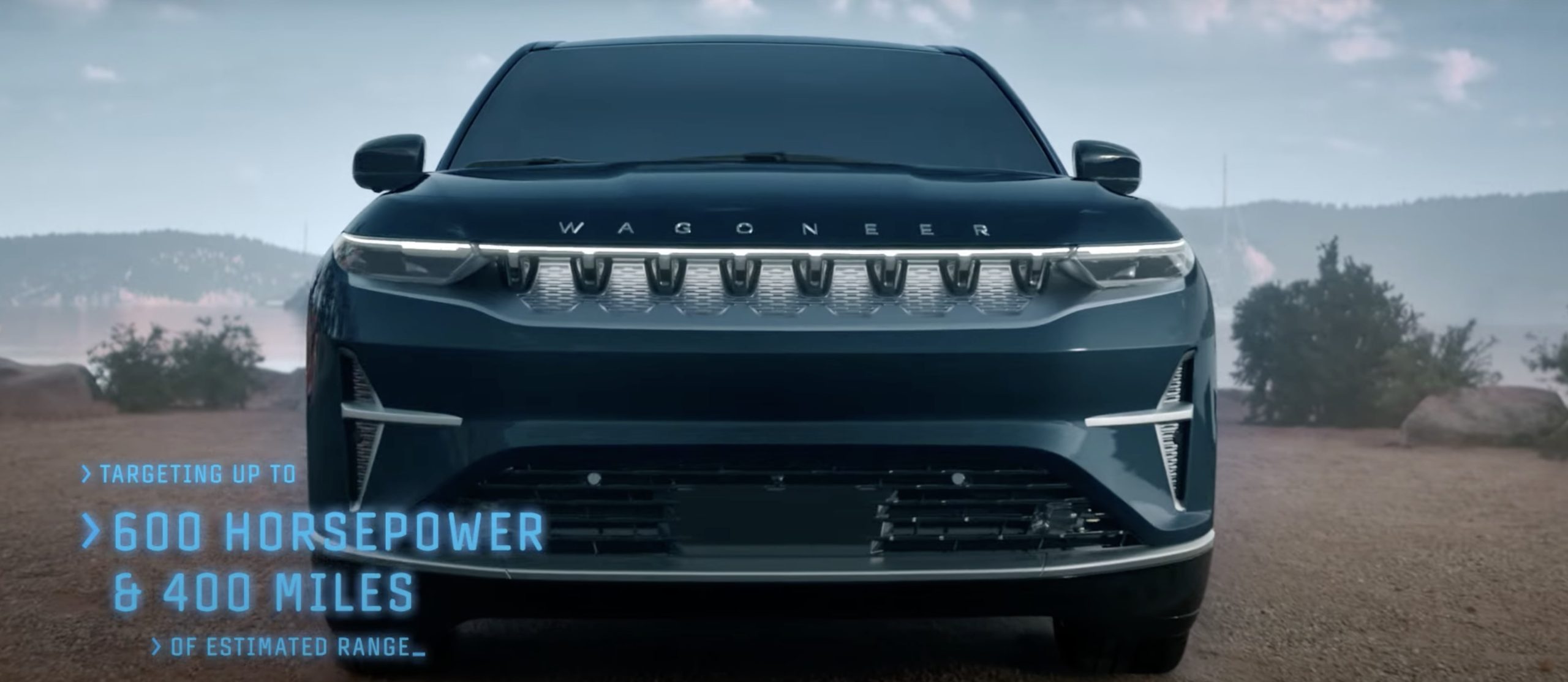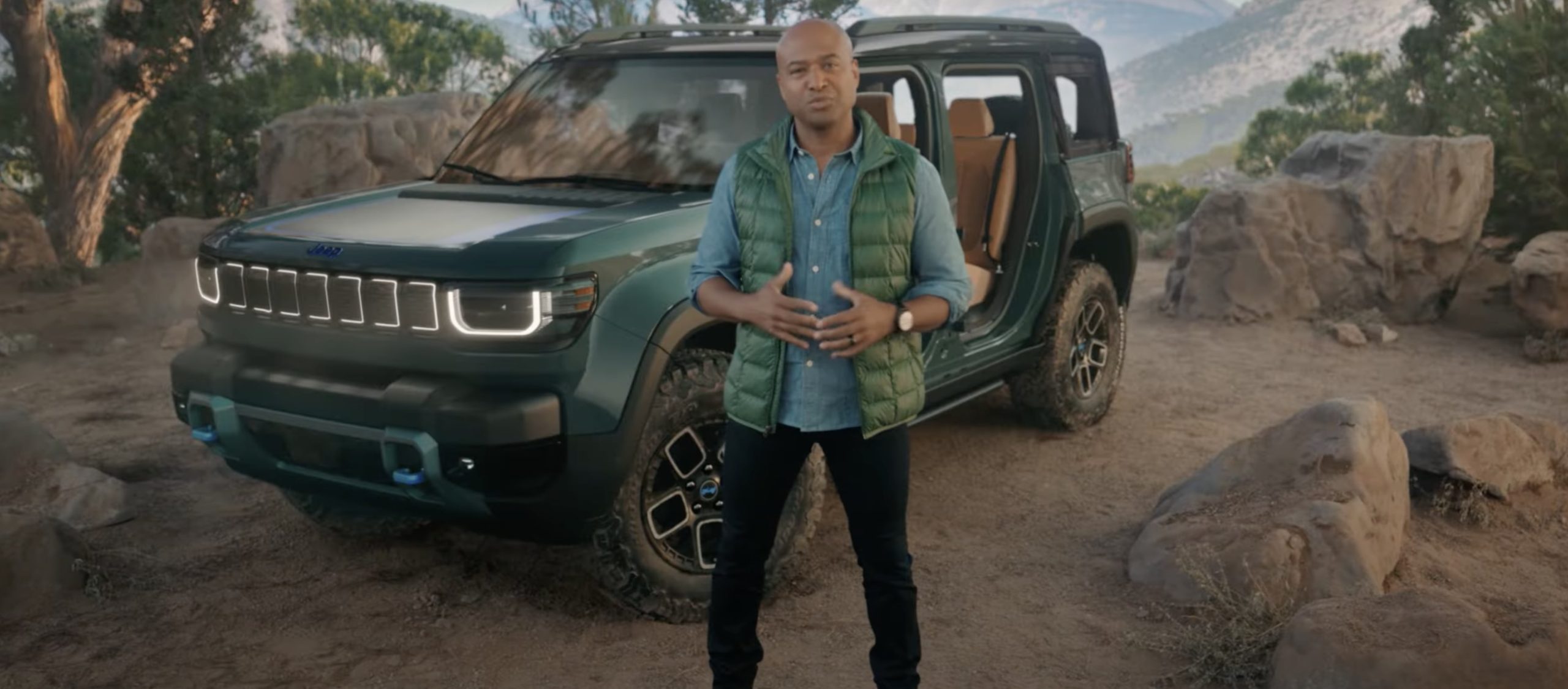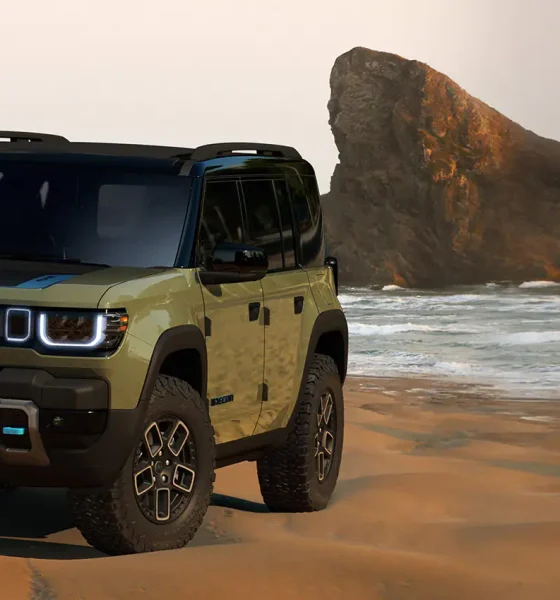During Jeep’s 4xe Day event, the brand announced it would introduce four new Jeep EV models by 2025.
Jeep and other American Stelantis-owned brands Dodge and Chrysler have been late to the electric vehicle market. Still, Jeep intends to change that by introducing four new all-electric models by 2025. In their 4xe event, they announced a fully electric Jeep Wagoneer, a Jeep Wrangler-inspired Jeep Recon (an all-new model name), a Europe-based Jeep Avenger (what has been previously teased as a Jeep Jeepster), and a slew of PHEV models that will come to North America.
After hemorrhaging money in paying for carbon credits, primarily in Europe, the American Stelantis brands are now introducing their first all-electric models as part of their 100% EV sales goal for Europe and 50% EV sales goal in the U.S. by 2030.
Jeep Wagoneer S EV
The first model shown in Jeep’s 4xe event was the all-new Jeep Wagoneer S EV. This electric rendition of the now incredibly popular Jeep Wagoneer offers far more angular styling and lighting and a series of aerodynamic upgrades to aid in the vehicle’s efficiency. Most notably, the Jeep Wagoneer EV now adopts a BMW X4 coupe styling as the back window is aggressively slanted, as a wing compliments the rear of the vehicle. Jeep shared a few specs for the Wagoneer S EV; the SUV would have ~400 miles of range (643.738 kilometers), 600 horsepower, and a 0-60 of ~3.5 seconds. No other specifications were released.

Jeep Grand Wagoneer S EV (Credit: Jeep)
Jeep Avenger EV
Jeep’s Avenger, the first of two new model names announced, will be Jeep’s first all-electric offering in Europe and will be available early next year. The Jeep Avenger is the vehicle that has been inaccurately rumored to be the Jeep Jeepster, though it may come to the U.S. under that model name. The small crossover SUV is ideal for the European market and offers a playful look and feel. Similarly to the wagoneer, limited specifications were released, but the vehicle will have ~400 kilometers (248.548 miles) of range.
Jeep Avenger EV (Credit: Jeep)
Jeep Recon EV
Finally, the Jeep Recon is the brand’s new serious all-electric off-roader. Inspired by the Jeep Wrangler, the vehicle has styling reminiscent of the Ford Bronco and Land Rover Discovery. Jeep gave no specifications for this vehicle, but the brand stated that it was focused on maximizing off-road capability, fun, and freedom. If built off of the Jeep Wagoneer EV platform, the vehicle would likely not be capable of the same 400-mile range due to its decreased aerodynamics and more capable suspension setup but could retain the incredible 600 horsepower.
Jeep Recon EV (Credit: Jeep)
Excitingly, Jeep only showed off three fully electric vehicles that would be introduced by the end of 2024, but they stated that the brand would release four. Some have speculated that the brand may be working on an electric truck model based on their Jeep Gladiator platform.
Overall, this is exciting news for the heritage brand! Jeep is one of a few brands attempting to infuse fun and enjoyment into each vehicle. With electric powertrains, their vehicles can become more fun and cleaner simultaneously, and it is good news that they have recognized this fact.
https://youtu.be/bQNxyMYXHmY
What do you think of the article? Do you have any comments, questions, or concerns? Shoot me an email at william@teslarati.com. You can also reach me on Twitter @WilliamWritin. If you have news tips, email us at tips@teslarati.com!

News
Tesla starts showing how FSD will change lives in Europe
Local officials tested the system on narrow country roads and were impressed by FSD’s smooth, human-like driving, with some calling the service a game-changer for everyday life in areas that are far from urban centers.

Tesla has launched Europe’s first public shuttle service using Full Self-Driving (Supervised) in the rural Eifelkreis Bitburg-Prüm region of Germany, demonstrating how the technology can restore independence and mobility for people who struggle with limited transport options.
Local officials tested the system on narrow country roads and were impressed by FSD’s smooth, human-like driving, with some calling the service a game-changer for everyday life in areas that are far from urban centers.
Officials see real impact on rural residents
Arzfeld Mayor Johannes Kuhl and District Administrator Andreas Kruppert personally tested the Tesla shuttle service. This allowed them to see just how well FSD navigated winding lanes and rural roads confidently. Kruppert said, “Autonomous driving sounds like science fiction to many, but we simply see here that it works totally well in rural regions too.” Kuhl, for his part, also noted that FSD “feels like a very experienced driver.”
The pilot complements the area’s “Citizen Bus” program, which provides on-demand rides for elderly residents who can no longer drive themselves. Tesla Europe shared a video of a demonstration of the service, highlighting how FSD gives people their freedom back, even in places where public transport is not as prevalent.
What the Ministry for Economic Affairs and Transport says
Rhineland-Palatinate’s Minister Daniela Schmitt supported the project, praising the collaboration that made this “first of its kind in Europe” possible. As per the ministry, the rural rollout for the service shows FSD’s potential beyond major cities, and it delivers tangible benefits like grocery runs, doctor visits, and social connections for isolated residents.
“Reliable and flexible mobility is especially vital in rural areas. With the launch of a shuttle service using self-driving vehicles (FSD supervised) by Tesla in the Eifelkreis Bitburg-Prüm, an innovative pilot project is now getting underway that complements local community bus services. It is the first project of its kind in Europe.
“The result is a real gain for rural mobility: greater accessibility, more flexibility and tangible benefits for everyday life. A strong signal for innovation, cooperation and future-oriented mobility beyond urban centers,” the ministry wrote in a LinkedIn post.
News
Tesla China quietly posts Robotaxi-related job listing
Tesla China is currently seeking a Low Voltage Electrical Engineer to work on circuit board design for the company’s autonomous vehicles.

Tesla has posted a new job listing in Shanghai explicitly tied to its Robotaxi program, fueling speculation that the company is preparing to launch its dedicated autonomous ride-hailing service in China.
As noted in the listing, Tesla China is currently seeking a Low Voltage Electrical Engineer to work on circuit board design for the company’s autonomous vehicles.
Robotaxi-specific role
The listing, which was shared on social media platform X by industry watcher @tslaming, suggested that Tesla China is looking to fill the role urgently. The job listing itself specifically mentions that the person hired for the role will be working on the Low Voltage Hardware team, which would design the circuit boards that would serve as the nervous system of the Robotaxi.
Key tasks for the role, as indicated in the job listing, include collaboration with PCB layout, firmware, mechanical, program management, and validation teams, among other responsibilities. The role is based in Shanghai.
China Robotaxi launch
China represents a massive potential market for robotaxis, with its dense urban centers and supportive policies in select cities. Tesla has limited permission to roll out FSD in the country, though despite this, its vehicles have been hailed as among the best in the market when it comes to autonomous features. So far, at least, it appears that China supports Tesla’s FSD and Robotaxi rollout.
This was hinted at in November, when Tesla brought the Cybercab to the 8th China International Import Expo (CIIE) in Shanghai, marking the first time that the autonomous two-seater was brought to the Asia-Pacific region. The vehicle, despite not having a release date in China, received a significant amount of interest among the event’s attendees.
Elon Musk
Elon Musk and Tesla AI Director share insights after empty driver seat Robotaxi rides
The executives’ unoccupied tests hint at the rapid progress of Tesla’s unsupervised Robotaxi efforts.

Tesla CEO Elon Musk and AI Director Ashok Elluswamy celebrated Christmas Eve by sharing personal experiences with Robotaxi vehicles that had no safety monitor or occupant in the driver’s seat. Musk described the system’s “perfect driving” around Austin, while Elluswamy posted video from the back seat, calling it “an amazing experience.”
The executives’ unoccupied tests hint at the rapid progress of Tesla’s unsupervised Robotaxi efforts.
Elon and Ashok’s firsthand Robotaxi insights
Prior to Musk and the Tesla AI Director’s posts, sightings of unmanned Teslas navigating public roads were widely shared on social media. One such vehicle was spotted in Austin, Texas, which Elon Musk acknowleged by stating that “Testing is underway with no occupants in the car.”
Based on his Christmas Eve post, Musk seemed to have tested an unmanned Tesla himself. “A Tesla with no safety monitor in the car and me sitting in the passenger seat took me all around Austin on Sunday with perfect driving,” Musk wrote in his post.
Elluswamy responded with a 2-minute video showing himself in the rear of an unmanned Tesla. The video featured the vehicle’s empty front seats, as well as its smooth handling through real-world traffic. He captioned his video with the words, “It’s an amazing experience!”
Towards Unsupervised operations
During an xAI Hackathon earlier this month, Elon Musk mentioned that Tesla owed be removing Safety Monitors from its Robotaxis in Austin in just three weeks. “Unsupervised is pretty much solved at this point. So there will be Tesla Robotaxis operating in Austin with no one in them. Not even anyone in the passenger seat in about three weeks,” he said. Musk echoed similar estimates at the 2025 Annual Shareholder Meeting and the Q3 2025 earnings call.
Considering the insights that were posted Musk and Elluswamy, it does appear that Tesla is working hard towards operating its Robotaxis with no safety monitors. This is quite impressive considering that the service was launched just earlier this year.










